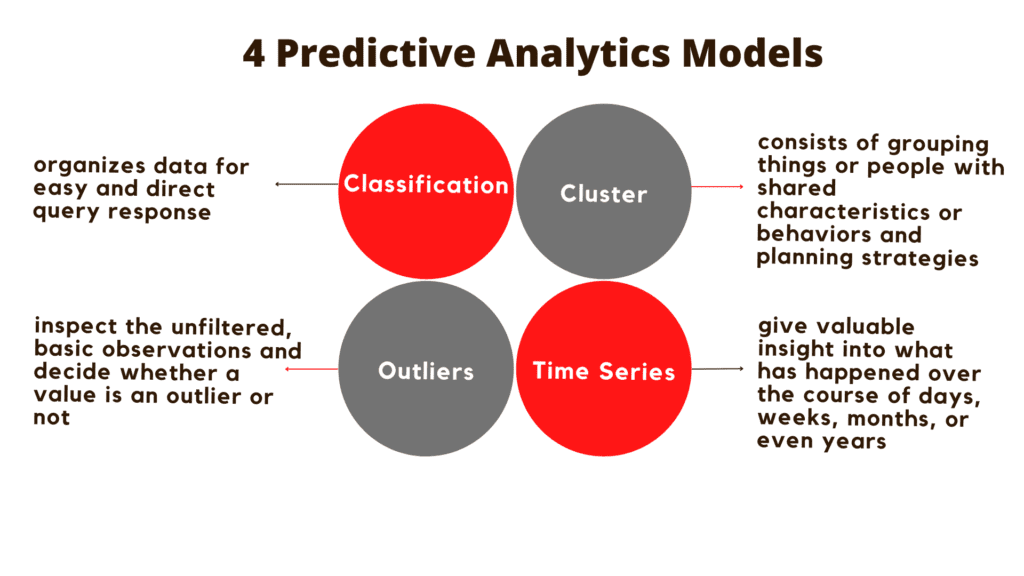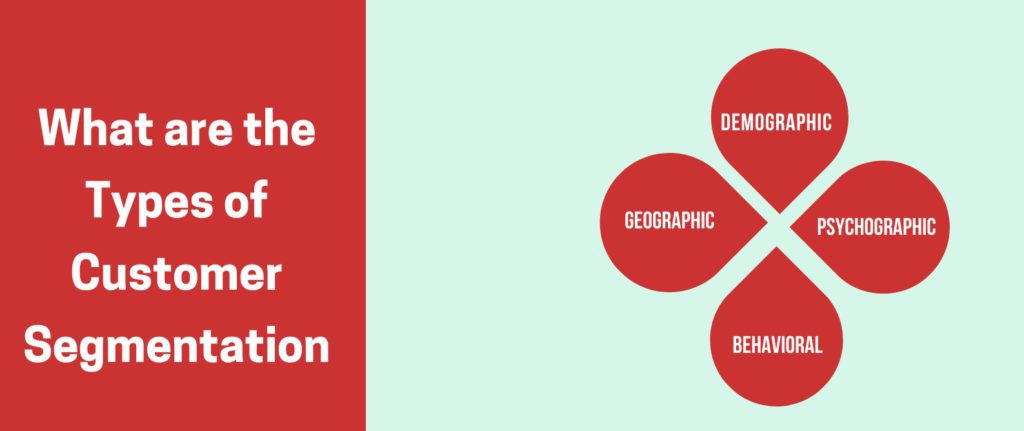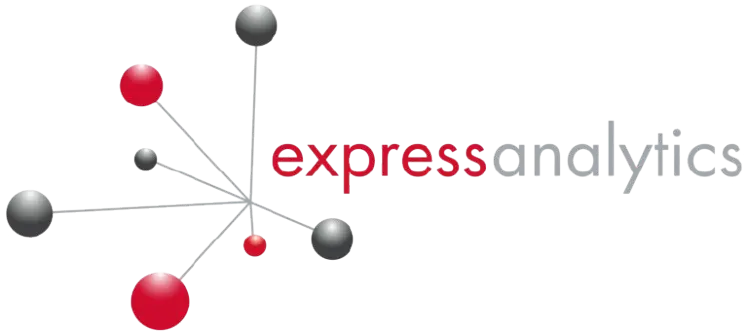What is Predictive Modeling?
Predictive modeling uses algorithms to analyze past data and forecast future outcomes, helping businesses predict sales trends and guide marketing decisions based on those insights.In a business model context, this is most commonly expressed as the analysis of previous sales data to predict future sales outcomes, then using those predictions to dictate what marketing decisions should be made.
What is Predictive Analytics?
Predictive analytics uses AI, machine learning, data mining, modeling, and statistics to forecast future outcomes, helping businesses make informed decisions about unknown future events.
Benefits of Predictive Modeling
The largest advantage you can gain from using this advanced technology is how easy it is to generate actionable insights; because the insights gained from business analytics predictive modeling are solely based on the truths of your organization’s actual business behavior, it is tailored specifically for your business’s needs and strategies.
The other major advantage of this concept is the value it offers to optimize marketing spend; by using this technology to determine which customers in your customer base have the highest proclivity to buy, you can better plan out your marketing campaign to avoid wasting money on segments that are not likely to provide sufficient return.
Why Do I need Predictive Modeling Services?
To illustrate how key predictive modeling in strategic marketing serves in optimizing your organization’s marketing strategy, let’s consider an example. Suppose you were a business that publishes a catalog every quarter to advertise your new line of products to your customer base.
If it costs a little over fifty cents (postage is $0.47 for the US, and printing en masse is likely around $0.03 per catalog at minimum) to print, and you have a total customer base of around 100 million customers, you are essentially looking at spending $50 million a quarter to send a catalog to every customer you currently have in your database.
In order for this marketing campaign to break even, you would need to receive more than $50 million in revenue in return for this ad campaign.
Obviously, it would be absurd to justify doing this once, let alone every quarter. Your marketing strategy works best when you minimize costs and maximize return, so for this campaign to be effective, you need to focus on the customers most likely to buy.
We need a mechanism to identify our best customer segments, and we can use their historical buying behavior and predictive modeling to determine this.
How Predictive Modeling is Done?
Predictive modeling techniques break down into a few key steps:
- First, all previous data collected is analyzed to determine what patterns or parameters the customers you already have followed, and thus what patterns both they and your future customers will follow.
- Next, You can use this predictive model to see which marketing campaigns in the past have seen success with each different segment of your customer base.
- Finally, you can determine which products that were advertised during each campaign did or did not successfully see a rise in sales, which in turn translates to whether those products have a reasonable chance of success if advertised; after all, if a product gets advertised for your marketing but does not see valuable results, it would be better to emphasize other products.
Top 4 Predictive Analytics Models are
- The Classification Model: It is considered the simplest, as it organizes data for easy and direct query response.
- The Cluster Model: In this model, data are clustered by common attributes. It consists of grouping things or people with shared characteristics or behaviors and planning strategies for each group at a larger scale.
- Outliers Model: Data points that are abnormal or outliers are used in this model. There is no one method to detect outliers because of the facts at the center of each dataset. One dataset is different from the other. A rule-of-the-thumb could be that you, the domain expert, can inspect the unfiltered, basic observations and decide whether a value is an outlier or not.
- Time Series Model: This model evaluates a series of data points based on time. Time series analysis can give valuable insight into what has happened over the course of days, weeks, months, or even years. Time series data analysis is the way to predict time series based on past behavior. Prediction is made by analyzing underlying patterns in the time-series data.

Best Approach to Predictive Modeling for Marketing
This technology offers a customized approach for marketing. A-One sizes fit all approach is usually not ideal for your marketing strategy, as the needs, your business, in particular, has might differ heavily from what works in a vacuum. A better approach in our opinion is Express Analytics’ ability to customize your models as per business requirements and do plenty of data wrangling and analysis before we implement these models.
Predictive Analytics Software
Generally, predictive models are just one type of advanced analytics and ML software. Some other models like RFM analysis, Identity resolution, Attribution models are not predictive in nature. They fall into statistical models(RFM), Optimization models(Attribution), Clustering or segmentation models, text mining. Together we call them advanced analytics. So I feel naming this just predictive analytics is not doing justice to our range of services or models. Here is the definition provided by gartner – Advanced Analytics is the autonomous or semi-autonomous examination of data or content using sophisticated techniques and tools, typically beyond those of traditional business intelligence (BI), to discover deeper insights, make predictions, or generate recommendations.
Advanced analytic techniques include those such as data/text mining, machine learning, pattern matching, forecasting, visualization, semantic analysis, sentiment analysis, network and cluster analysis, multivariate statistics, graph analysis, simulation, complex event processing, neural networks.
What is a Customer Data Platform CDP?
A customer data platform (CDP) is a “data unifying software”. Adding it on top of your MarTech stack helps manage your customer experience across every touchpoint — marketing, customer service, and product. It absorbs an enterprise’s data from all sources — batch, streaming, structured or unstructured, transaction or demographic — and makes it available 24X7 to all the enterprise users. The CDP Institute defines a Customer data platform as a persistent, unified customer database that is accessible to other enterprise systems, putting marketing indirect control of the data unification project. A CDP is not a CRM, a DMP, a data warehouse, or a data lake; the latter is where data is merely stored. A CDP is much more than that. It’s a sophisticated data hub where all things related to data converge — from data sources to customer information.
To cut a long story short, a customer data platform enables brands to make intelligent decisions around the right audience, giving them the right content at the right time using the right channel for the purpose.
On top of that, it should offer clear, actionable advice and steps to turn your goals into reality. To guide you toward the best decisions, a good plan will also lay out a variety of potential scenarios—plus some alternative ones—for you to consider.
What Kind of Data does a Customer Data Platform Handle?
Every customer inevitably leaves behind information while interacting with a brand. When they surf the Internet or interact with companies using other online and offline channels like websites, e-commerce platforms, and in-store interactions, their footprints can be tracked. Here’s some of the data that a customer data platform (CDP) uses:
Transactional data
Includes information such as items purchased, number of abandoned carts, returned products
Customer attributes
Includes name, gender, contact information
Customer service info
Includes customer communications, live chat, number of interactions, and so on
Why a Customer Data Platform (CDP) cannot be Compared to a CRM or a DMP?
Yes, it is a fact that a customer data platform and customer relations management (CRM) tools both collect customer data. The similarities end there, period. Here are some of the differences between a CDP, a CRM, and a DMP:
- A CDP collects data on anonymous visitors, but a CRM gathers data around known customers or leads
- A CRM has a limited purpose: it analyzes only the sales pipeline while a CDP analyzes lifetime customer behavior and customer journeys
- A CDP can track online and offline customer data. In the case of a CRM, it cannot collect offline data unless someone manually enters it
- A CDP influence deals with all types of marketing while a DMPs largely influences advertising
- A CDP collects mostly first-party data, which means straight from the source but a DMP collect mostly third-party data
- A CDP retain data over a long period of time unlike a DMP
What is Identity Resolution?
Conventional rules for reaching customers have experienced a paradigm shift — customers are no longer tied to a single device. This means it has become difficult to identify customers as they move between various channels. To tackle this problem, you need to build an identity framework that unifies a customer’s experience regardless of the channel, and to create a means to ensure targeted and relevant marketing offerings to that customer.
By doing so, you are granted a 360° ‘Customer View’, and a ‘Unified Customer Experience’. A 360° view means we have enough information to have a holistic understanding of a person, and can better model their buying behavior, thus increasing the success rate of our marketing to them. The other half is to have a unified customer experience.
Because we have an identity that links a person’s persona across all devices, we can provide the same quality of customer experience via mobile devices that we might give them in a face-to-face environment. The full process of creating a 360° customer profile and using it to provide a unified customer experience is referred to as identity resolution.
What is “in” now instead is cross-device ID tracking. This is a process of collecting and combining data around a single customer in a way that links all his/her devices used back to him/her. Why is cross-device tracking gaining importance? It is a fact that today, the average person owns multiple devices connected to the World Wide Web. Eg: laptops, smartphones, smart TVs, game consoles, etc.
Benefits of Identity Resolution
By creating an identity profile for each customer, you can better understand the context and intent of customer interactions with your business.
You can also be able to better predict sales figures by segmenting your customers by common profile qualities, offer near-real-time promotional offerings, and have a better handle on customer satisfaction and how to drive repeat purchasing.
Portability of identity also means that you can provide the same quality of service across all channels.
What is a Single Unified View?
Our unified Single Customer View holds all the most relevant data about the past, present, and expected future behavior of every single customer. Using a single source of customer intelligence, you can easily scale personalized customer experiences across all customer touchpoints.
How can a Customer Data Platform Help with Customer Personalization & Segmentation?
A customer data platform (CDP) can help you catch and visualize instant insights from your data in real-time. You may drill down as much as you want to capture the “connect” between what looks like unrelated data.Customer segmentation can help you in many ways: It helps a business develop focused strategies to hold on to its top-paying customers. Or, to re-engage those clients who haven’t purchased in a while. It is also used to provide a heightened customer experience.
- Customer data platform helps identify the least and most profitable customers, thus helping the business to concentrate marketing activities on those most likely to buy your products or services
- Helps build loyal relationships with customers by developing and offering them the products and services they want
- Helps improve customer service
- Helps maximize the use of your resources
- Helps improve or tweak products to meet customer requirements
- Helps increase profit by keeping costs down
Your Guide for Selecting a Customer Data Platform
A customer data platform is a “data unifying software”. Adding it on top of your martech stack helps manage your customer experience across every touchpoint – marketing, customer service, and product.
It absorbs an enterprise’s data from all sources – batch, streaming, structured or unstructured, transaction or demographic – and makes it available 24X7 to all users within the enterprise.
So what do I need to do to get it?
Getting a CDP customer data platform for your enterprise’s digital transformation requires some serious thinking. We call it the 5-step process that will act as a guide for you to eventually select the right CDP for your marketing team. Not to mention the fact that at last count, there were over 60 CDPs available in the market, adding to the overall confusion. But first and foremost, you need to understand if your enterprise is ready for a customer data platform.
Here’s a quick checklist for that:
- Are your business goals in place?
- Do you want to meet these goals with technology such as data analytics?
- Does your data sit in silos?
- Is your data accessible to a majority in your organization? If not, can you make it accessible?
What is Customer Segmentation in Marketing?
Customer Segmentation: The dividing of a market’s customers into subgroups in a way that optimizes the firm’s ability to profit from the fact that customers have different needs, priorities, and economic levers. For companies looking to effectively scale their customer base, it is inefficient to simply use a one-size-fits-all marketing approach for a diverse group of customers.
Customer segmentation attempts to divide and classify the customer base with respect to various parameters to identify the best performing subgroup of customers and then target customer segments most similar to our best performers.
Definition of Customer Segmentation
The process of subdividing a market’s customers in a way that optimizes the potential profit from the fact that customers have different needs, priorities, and economic levers is called customer segmentation.
If a company wants to efficiently scale its customer base, using a one-size-fits-all marketing approach is inefficient. Segmentation attempts to identify the best-performing customer base by dividing and classifying it based on various parameters and then targets customers that are similar to those customers.
Customer segmentation divides the customer into groups based on different factors and where each group shows some unique characteristics of customers in that group. It has been widely used by businesses to know more about their customers and their purchasing patterns to meet their needs by changing the business strategies accordingly.

How to Perform Customer Segmentation Using Machine Learning?
Machine learning (ML), a sub-discipline of artificial intelligence (AI) works as a magic tool for customer segmentation because manual customer segmentation can take months or even years based on the amount of data.
There are various unsupervised machine learning algorithms used for segmentation like K-means, K-Prototype, K-Modes, DBSCAN, BIRCH, etc. All these techniques come under a methodology called “Clustering”.
Can we Automate the Customer Segmentation Process?
The literature says the customer segmentation process can’t be “develop once and use forever” as data may change and the same steps can’t work.
But Express Analytics has automatized the customer segmentation process by creating a pipeline that can give recommended segments, and these segments can be changed based on the attributes selected by the user.
Creating a supervised learning pipeline is rather easy than an unsupervised learning pipeline as data is labeled in supervised learning. We are using clustering (unsupervised learning process) for customer segmentation.
It has the following steps:
1. Data Aggregation: The user selects the attributes on which they want to perform segmentation. These attributes are then converted into a dataset and become input for the pipeline.
2. Data Pre-processing: There are various key steps in data preprocessing like:
- Missing Values: If we work on data individually, we can impute the missing values or drop some of them based on their effect on the whole dataset. But, while automatizing, we can’t look deep into the dataset and decide whether to impute or drop those values. So, to make it simple, we are dropping the columns which have null values.
- Duplicate Values: There can be multiple transactions for a single customer id. But these duplicate customer ids are of no use while clustering. So, we have dropped the duplicates on the basis of customer ID attributes.
- Unique Values: In a dataset, the columns which have more unique values are not usually suitable for clustering. So, to know which columns have the most unique values, we found out the number of unique values in each column and then discarded those columns which had more than 75 percent of unique values or only 1 unique value.
3. Data Types: A dataset may contain numerical(int, float), categorical (object), and DateTime columns. Most unsupervised learning algorithms work on numerical data, so we need to convert categorical columns into numerical data. We are dropping DateTime columns for now as they may be audit dates etc., which will be of no use.
How to Convert Categorical Data to Numerical Data?
Categorical to Numerical data conversion: K-means is the most commonly used clustering technique but it only works with numerical data. So, we have to convert categorical data into numerical data. There are many ways of doing this customer segmentation.
Some of them are:
a. One Hot Encoding: This type of encoding is done where values are nominal. It creates different columns for each unique value of a categorical variable. The advantage is that it is easy to apply and it can be inverse transformed also. However, it increases the curse of dimensionality.
b. Label Encoding: This encoding is mainly for ordinal columns where the order of the values has to be maintained. It converts the categorical values into integer numbers. Its use is not advised for nominal values.
c. Binary Encoding: This encoding uses one-hot encoding with hashing. Here, the categorical features are converted into numeric values which are then converted into binary values. This is a memory-efficient encoding scheme.
d. Base N Encoding: This encoding is the same as Binary encoding. The only difference is hashing is not done with base 2, it can be with any base. This encoding is good when there are more categories.
4. Model Implementation: There are various clustering techniques mentioned in the literature where K-Means are the most common among them. However, it only works with numerical data. K-Modes is the technique used only with categorical data.
Now, to work with both numerical and categorical data, the K-Prototype clustering technique comes into the picture. We have used K-Means and K-Prototype for customer segmentation.
K-Means: To use K-Means, we converted the categorical columns using Binary encoding as there can be multiple unique values in a column and one-hot encoding will increase the dimensionality.
We scaled all the data using the StandardScaler function so that there is a standard mean and variance. The results of K-means are visualized using a parallel coordinate approach where the centroids of each cluster are taken and plotted parallelly.
The Elbow method is used to find the optimal number of clusters.

K-Prototype: It works with both numerical and categorical data. Here, we don’t need to convert categorical data, we can just mention which are the categorical columns in the whole dataset.
As it works with categorical columns itself, its training time is more than K-Means. It can also be visualized using cluster centers. The Elbow method can be used to find the optimal number of clusters.
Once clusters are assigned to each customer, the visualization explains the distinguishable segments defining the behavior of different customers.
Sometimes, the clusters produced by K-prototype are more informative than K-Means and it can also reduce the extra effort of converting categorical columns.
Benefits of Customer Segmentation
Through customer segmentation model, a company can target specific groups with marketing campaigns tailored to their needs and in a way that will resonate with the targeted segment, but not necessarily other segments.
Customers are commonly segmented based on various parameters, namely:
- Needs – depending on what kind of products will satisfy the customers
- Spending behaviour – based on their spending behaviour like high spenders, value for money seekers etc, how often the customer makes purchases etc.
- Monetary value – how much revenue does the company make from these customers
- Recency – how recent are these customers, how often do they make purchases
- Demographics – the age, gender, ethnicity, religion of customers, etc.
Through customer segmentation, the marketing strategy used to target different segments can be optimised by:
- Identifying the optimal channel for marketing to the customer segment – catalogue, phone, email, flyer, etc..
- Marketing products to the segment which will be of interest to them.
- Leverage pricing options depending on the spending habits of the segment.
- Focusing marketing resources on most profitable customers to improve ROI.
CLV-Focused Customer Segmentation
One popular and perhaps the most effective method (according to a study conducted by Libai, Narayandas, and Humby in 2002) that companies use to segment their customers is based on a parameter called Customer Lifetime Value and aims to identify the most profitable customers.
Customer Lifetime Value of a customer is the total revenue generated from the customer over a lifetime of purchases and deducting the costs incurred in customer acquisition, while also accounting for the time value of money by segmenting customers based on CLV, an organization can target its most profitable customers resulting in maximization of marketing ROI.
CLV segmentation shifts the focus from targeting customers to leveraging marketing resources to target the most profitable customer segments.

